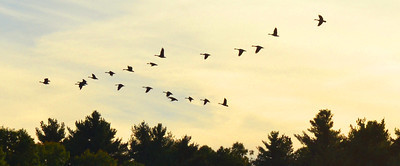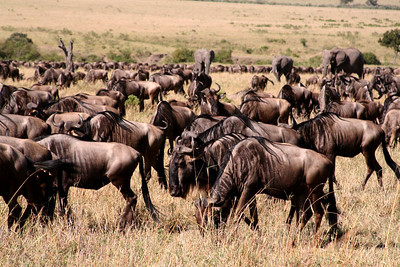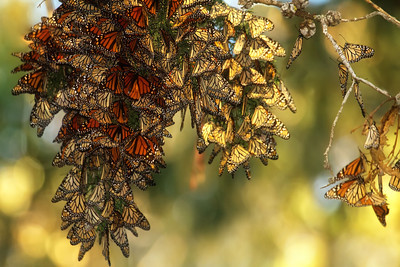Credits
Image: Migration by James H
Animals do many different and amazing things. Some of them ‘migrate’. This means they travel to other places where the weather is warmer or they can find more food.
Image: Migration by James H
Migration is a specific journey, and usually a very important one, that an animal takes regularly for a particular reason, usually at a particular time of year. Animals migrate so that they can survive; it is a form of adaptation.
Many habitats have wet/dry or cold/hot seasons and are therefore difficult to survive in all year round, so the animals have to either move away (migrate) or hibernate in the winter. Other areas may have more food or shelter or water available at certain times of year so the animals need to move there in order to survive. Some species (e.g. elephants and wildebeest) need to eat special minerals which are only available in certain places so they need to go there regularly to get them.
Most mammals that migrate overland are herbivores (plant eaters) and they move as the
weather changes over the seasons, and the vegetation growth changes. No carnivorous (meat-eating) land mammals regularly migrate, although packs of wolves may travel with caribou herds if food is scarce in their home territory.
As well as travelling in search of food, many birds will also migrate to places with fewer predators in order to breed and raise their young.
Insects also migrate. Some butterflies and moths fly very long distances. Most migrating insects go much shorter distances. Many, like termites and beetles, move downward into the soil. Earthworms also move down, some as far as six feet below the surface.
Of course some people migrate too. They might move to another town, county or country to find work, start a family, avoid a war or famine, or if they are lucky enough, simply to have a holiday. Some of course choose never to come back (emigration); most return after their holiday or when it is safe to return.
Why did birds start migrating to the UK? To understand why birds first chose to visit here, we need to go back 10,000 years to the end of the last Ice Age. New land that had been buried under ice for thousands of years began to appear as the ice melted away, as the climate became milder and wetter. This made a good place for the invertebrates that many birds feed on to live. The number of bugs increased over time and birds on the search for food decided that this new land was a good place to find it. Also, there were fewer predators and not much competition for food as few species had yet arrived on the new land. This was therefore an ideal home and a great place to lay eggs and raise their young!
So all was well during the summer months. However, in the winter the invertebrates died in the cold temperatures and it was too cold for many of these newly arrived birds to survive so they flew back to the warmer countries that they had originally come from. The ones that fled survived better than any that stayed, so they ended up making the journey every year and still do today.
But why leave their southern countries? Food doesn’t run out there so why fly all the way over here? It’s because Britain has fewer predators, more space, less competition from other species and longer days in the summer, which means more time in the day to find food. All these are important to birds when they are trying to raise babies and find enough food for them.
So migratory birds fly backwards and forwards each season between the best place for feeding and the best place for breeding as the seasons change.
How do birds know when to start their journeys? Well it depends on the type of migration, but generally speaking in Britain there are seasonal clues such as the weather getting colder and the days getting shorter towards autumn time which tells the birds when to leave.However, at the Equator, where there are no seasons and the temperature is fairly consistent throughout the year, it could be the number of days that the birds have been there that makes them restless at about the right time. For other types of migration, food perhaps becomes harder to find, overcrowding begins to become a problem, or the birds’ fat reserves run low (they get thin and hungry) and they know it is time to move to a new area to find food.
One of the amazing things about bird migration is how the birds know where they’re going. They can’t read maps or use compasses and it’s a very, very long way, so how on earth do they navigate? One of the main ways they do it is by learning the route from their ancestors; it is instinctive: it is in their genes that they just know where to go. Some bird species have a mineral called magnetite above their nostrils. This helps them to use the Earth’s magnetic field to navigate.
Scientists also believe that birds use a combination of the landscape features – such as a coastline or mountains, almost like they are reading a map! Finally, some birds, such as starlings, use the position of the sun to guide them and others, such as mallards navigate by the stars.
The journeys that migrating birds take can cover enormous distances. The ruby-throated hummingbird travels non-stop for 24 hours across 965km of open ocean from the US Gulf Coast to the Yucatan Peninsula in Mexico, yet only weighs 4.8g! Bar-tailed godwits fly 11,000km (one did this non-stop!) from Alaska to New Zealand.
Birds that migrate have developed special adaptations to help them survive such long journeys. Most migratory birds have hollow bones which make them lighter and therefore better at flying up high in the winds to help carry them along. Some birds develop larger, more powerful breast muscles for flying and have smaller non- essential organs to lighten the load! Many fly in the prevailing winds or thermals (warm air spirals) to help gain distance and height. Geese fly in a ‘V’ shape, changing the leader at the front regularly, to reduce drag. They fly in each other’s slipstream so it’s not such hard work.
Birds also change their feeding behaviours to help them prepare for migration. Most will build up extra fat reserves in the weeks leading up to the long journey (some double their body weight) so they have spare ‘food’ as many don’t eat during migration. Many migratory birds travel in large numbers so they are safer from predators. Stop-offs (short breaks) en route for a rest are common.
Photo: Ashok Boghani

Of the mammals that migrate, Caribou (reindeer) undergo the longest overland migration. Three million of them travel across the Arctic Tundra to find greener pastures and therefore more food. Some cover more than 3,000km each year.
 One of the most famous mammal migrations is the great wildebeest migration across the Serengeti in Africa. Zebra and Thompson’s gazelle also travel with these grunting, horned animals in vast numbers. The images people remember tend to be the ones where they have to cross big rivers where hungry crocodiles lie in wait to catch the weak and young animals.
One of the most famous mammal migrations is the great wildebeest migration across the Serengeti in Africa. Zebra and Thompson’s gazelle also travel with these grunting, horned animals in vast numbers. The images people remember tend to be the ones where they have to cross big rivers where hungry crocodiles lie in wait to catch the weak and young animals.
The animals move to find better grazing (more grass) and water as the weather becomes drier and the grass stops growing. They have to move off from their breeding grounds in the Serengeti
when the dry weather approaches early in the year. No-one knows how they know when to leave and it is never exactly the same time from one year to the next. But gradually they all begin to move off in their thousands and head north to the wetter Masai Mara over the border in Kenya. Their journey is far from easy. They have to cross two big rivers during their journey, the Grumeti and the Mara, where enormous hungry crocodiles pick off the exhausted, weak, diseased or young ones. Finally arriving in the Masai Mara in about July, they remain there until October when they head back to the Serengeti as the rains return there. As many as 200,000 will die along the way, either from predation, disease, old age or exhaustion.
Many species of whale (which don’t forget are mammals) also migrate vast distances to find food. Baleen whales such as the Grey, Blue, Right, Minke and Humpback whale feed on krill - small, shrimp-like crustaceans with black eyes thatfloat in huge shoals in the world’s in the oceans. Krill thrives in cool waters so the whales head north in the northern hemisphere and south in the southern hemisphere to feed, and then head back to warmer waters to give birth.
Humpback whales travel from Costa Rica and Hawaii to Antarctica to feed in the krill-rich cooler waters there. Their young are born in the warmer waters further north in Costa Rica when they return in the autumn. This journey is more than 8,000km.
Grey whales know where to go by navigating the 16,000 km using the magnetite in their eyes to “read” the Earth’s magnetic field!
Photo: Alan Green
The best known migratory reptiles are turtles. Turtles live most of their lives in the sea, except for when it is time for the females to lay their eggs. They then head to their breeding beaches, haul themselves out of the water, lay and then bury their eggs in the sand before heading back to the sea once again. These beaches can be thousands of miles from the turtles’ feeding grounds. When the tiny baby turtles hatch, they immediately crawl their way down the beach to the safety of the sea without the guidance of their parents.
Baby Loggerhead turtles can find their way along a 13000km migration route without guidance from their parents. Even when scientists have led them off course, they found their way back without any problem. But when they were exposed to a variety of magnetic fields that were different to the Earth’s magnetic field, they went off course, only to go the correct way when the Earth’s magnetic field was restored!
One leatherback turtle made the longest recorded water journey: 20,558km in 647 days!
Many species of sharks, eels and other fish also undertake massive journeys, usually for breeding purposes, yet people think that fish have terrible memories!
Salmon are well known for their migratory habits. They migrate in order to breed somewhere safer than their main feeding areas. This is known as reproductive migration. The adult salmon live in the open seas of the Atlantic Ocean but return to the freshwater streams and rivers where they were born, to lay their eggs. They use their sense of smell to find their way. Young salmon wouldn’t have such a good chance of survival in the open sea – there are too many predators and other hazards; it is safer to start life in a river. Once they are in the stream or river, the adults stop eating and lay their eggs before returning to the sea once again. The young salmon hatch and spend up to 5 years in the rivers before making their way out to sea. Here they stay until they are old enough to return up the river. Pacific salmon have a similar migration pattern but they don’t return to the sea once they have spawned (laid their eggs); they die in vast numbers once their eggs are laid.
Basking sharks are the second largest shark in the world. They undertake a 16,000 kilometre migration journey into the deep waters of the Western Atlantic from New England, US. They head out beyond the equator, swimming so deeply (200 to 1000 metres beneath the surface) that they have never been spotted making the journey. No one really knows why they migrate as there is plenty of food and warm water in their northern home near Florida. It is thought that they may be seeking out new breeding grounds.
Even insects and other invertebrates migrate! Most die in winter or hibernate to avoid the cold winter temperatures, but some migrate instead. Termites and earthworms migrate byburying themselves deeper into the soil in the cold winter months to avoid getting frozen.
The most famous invertebrate migration is that of the Monarch Butterfly. As autumn approaches, the butterflies begin to gather in clusters in their thousands throughout North America. They then fly south to the warm forests of Mexico – a journey of more than 1600km – returning north again the following spring. They rest in trees along the way – using the very same trees every year.
However, the strange thing is that the return journey takes longer than the butterflies’ life-span, so the butterflies that fly home are different to the ones that flew out! Each migrating butterfly will never make the trip again. In fact 2 or 3 generations have been and gone before the return journey is made! The offspring follow exactly the same route and roost in the same trees as their great grandparents on the way over. We have no idea how they know to do this. The reason they make the journey is probably because it is too cold to stay year round in North America, whilst the food their larvae feed on (milkweed) doesn’t grow in such abundance in the southern regions so they have to fly north again to where does.
 Photo: Sandy/ Chuck Harris
Photo: Sandy/ Chuck Harris